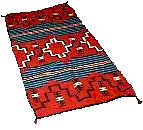
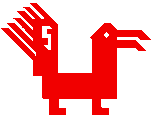 Navajo Rug Appraisal Co.
Navajo Rug Appraisal Co.
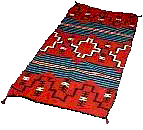

 Navajo Rug Appraisal Co.
Navajo Rug Appraisal Co.

Regional Navajo Rugs
Characteristics of Regional Navajo rugs
The Ganado style Navajo rug generally consists of one stepped diamond shaped center medallion or two connected stepped diamonds. Stepped and embellished triangles in each corner make up a quincunx pattern all surrounded by a geometric border. The colors consist of red, grey, ivory, black and sometimes brown. The predominant "Ganado red" color is colored with synthetic dyes as was the black color.
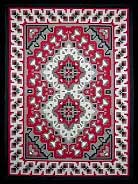
Klagetoh rugs are thought in the trade to be from an area south of Ganado, Arizona. According to prevailing wisdom, these rugs are very similar in styling and coloring but have a predominantly grey background rather than the red background of Ganado regional rugs. Some people, including this author, do not consider Klagetoh as a separate regional style but think of Ganado and Klagetoh as one regional rug weaving area.
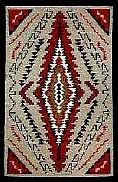
This style was established after 1911 by George Bloomfield and Ed Davies at Toadlena and Two Grey Hills trading posts. Two Grey Hills rugs are similar in design layout as Ganado Navajo rugs but generally have colors of browns, tan, grey, ivory, black (often over-dyed black) and sometimes small amounts of red, orange or turquoise.
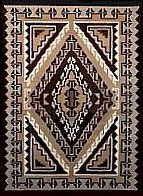
Burntwater rugs use designs that are much like the Two Grey Hills style rugs but are woven using vegetal dyed colors or colors that imitate natural dyes. This style of rug was developed in the mid 1968 by Philomena Yazzie and was encouraged by trading post operator Don Jacobs. The weavers used vegetal dyes to achieve the unique colorings of Burntwater rugs. Early Burntwater rugs such as those by
Philomena Yazzie had strong colors of green and gold. Later, Bruce Burnham of Sanders encouraged weavers to use more colors in each rug and to use commercially dyed wool yarns. Pinks, mauves and greys were very popular in the 1980's.
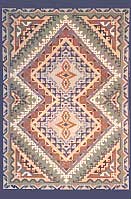
The designs of Teec Nos Pos rugs show even greater influence from the designs of Oriental rugs. It was important during the early third of the 20th century that, in order to sell to Anglos, Navajo weavings had to look like rugs. The rugs to which I refer are, of course, Oriental or Persian rugs. Indeed, the Teec Nos Pos rugs look like flatwoven Navajo versions of Oriental rugs; intricate multi-bordered designs with Oriental rug fields in numerous bright colors.
In the same Four Corners area are woven intricate multi-colored rugs using "Eyedazzler" patterns from the late 1900's. These "Red Mesa" rugs are considered by many to be another style of Teec Nos Pos and therefore the same regional area, Teec Nos Pos / Red Mesa.
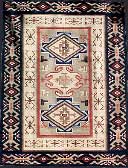
J. B. Moore, a trader at Crystal, NM published a catalog in 1911 that had a design he developed that much later came to be known as the "Storm Pattern." This design consists of a square or rectangle center with echoing rectangles at each corner connected by zigzag bars or some other connecting device all surrounded by a border. The design has been associated with the western part of the reservation, particularly Tuba City but, in fact, has been woven throughout the entire reservation. This fact, in effect, makes the Storm Pattern rug a non-regional rug style. Juan Lorenzo Hubbell at Ganado seems to have knocked off the design and showed it in one of the paintings he had made in order to show weavers as well as customers.
One story about the design origin is that it was derived from the labels on four sacs sold to Navajos in the early years. There are no labels that show anything like this design (the same story is often written concerning the swastika design as found in some Navajo rugs). The "Storm Pattern" design shows the favored quincunx pattern, a ubiquitous design styling in the Orient. Despite stories told by Indian arts dealers and, even today, some Navajos, the design does not represent four sacred mountains or four directions. The first time that the term, "Storm Pattern" was used in a publication was 1961.

The Chinle style Navajo rug was developed by Boston Brahmin Mary Cabot Wheelwright and Cozy McSparron a trader at Chinle who sought to revive Navajo weaving using the Classic Period designs along with vegetal dyes. Ms. Wheelwright and her affluent lady friends in Santa Fe financed much of the weaving. These rugs eventually became rather popular and the style spread to other weaving areas on the reservation. The design characteristics are horizontal bands containing rhomboids and chevrons in muted colors of gold, green, tan, ivory and pink.
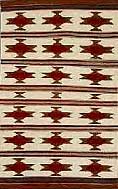
Rugs from the Wide Ruins area copy the design and coloring of the Chinle rugs but tend to be more intricate with more colors. Somewhat unique to these rugs are a design feature of alternating weft colors (one shoot of a color alternating with one shoot of another) which create horizontal bands resembling railroad tracks. Large rugs with the same styling are also woven in the area of Wide Ruins. Wide ruins rugs may also show lozenges that are connected within the wide bands. The trading post at Wide Ruins no longer exists due to a fire, a fate shared by several other trading posts.
Pine Springs rugs are very similar to Wide Ruins rugs but tend to be finer and use more green colors. Most people view Pine Springs and Wide Ruins to be the same regional rug weaving area.
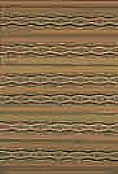
Crystal rugs from the mid 1930's and after show the same design styling as Wide Ruins and Chinle. Somewhat unique to Crystal rugs are the use of two weft shoots alternating with two more weft shoots of another color which create a wavy line effect. Please note that the more modern Crystal rugs are much different than the earlier J. B. Moore Style Crystal rugs which show a variety of Oriental rug and other patterning.

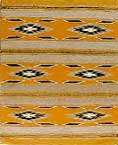
By far the largest category of Navajo rugs would be non-regional, sometimes called "general rugs." These rugs do not exhibit unique characteristics that allow them to be pinpointed to a specific regional trading post area. Either no design elements stand out or the style of rug was, or is, woven throughout Navajo land. While Indian arts dealers will try assign a regional attribution to almost any rug, many rugs fall into the non-regional category. The photo below is only one example of a non- regional Navajo rug. There are many designs that fall into this category.
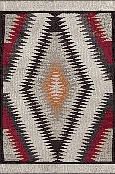
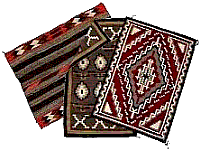
Thank you for visiting Navajo Rug Appraisal Co. online.
![]() Navajo Rug Appraisal Co.
Navajo Rug Appraisal Co.![]()
Mailing address:
Email
rugvalue@yahoo.com
Copyright © 1997-2024, All Rights Reserved.

Navajo Rug Pages:
Oriental Rug Pages:
Miscellaneous Pages: